How To Make Sauerkraut
This post may contain affiliate links. See my disclosure policy.
A comprehensive, step-by-step pictured tutorial on How to Make Sauerkraut that is incredibly healthy and delicious! Making your own fermented homemade sauerkraut is super easy, requires minimal prep work, and the rest is just a waiting game. This Sauerkraut recipe covers everything you need to know to ensure your success!
For another probiotic-packed food, be sure to check out my tutorial for How to Make Yogurt!
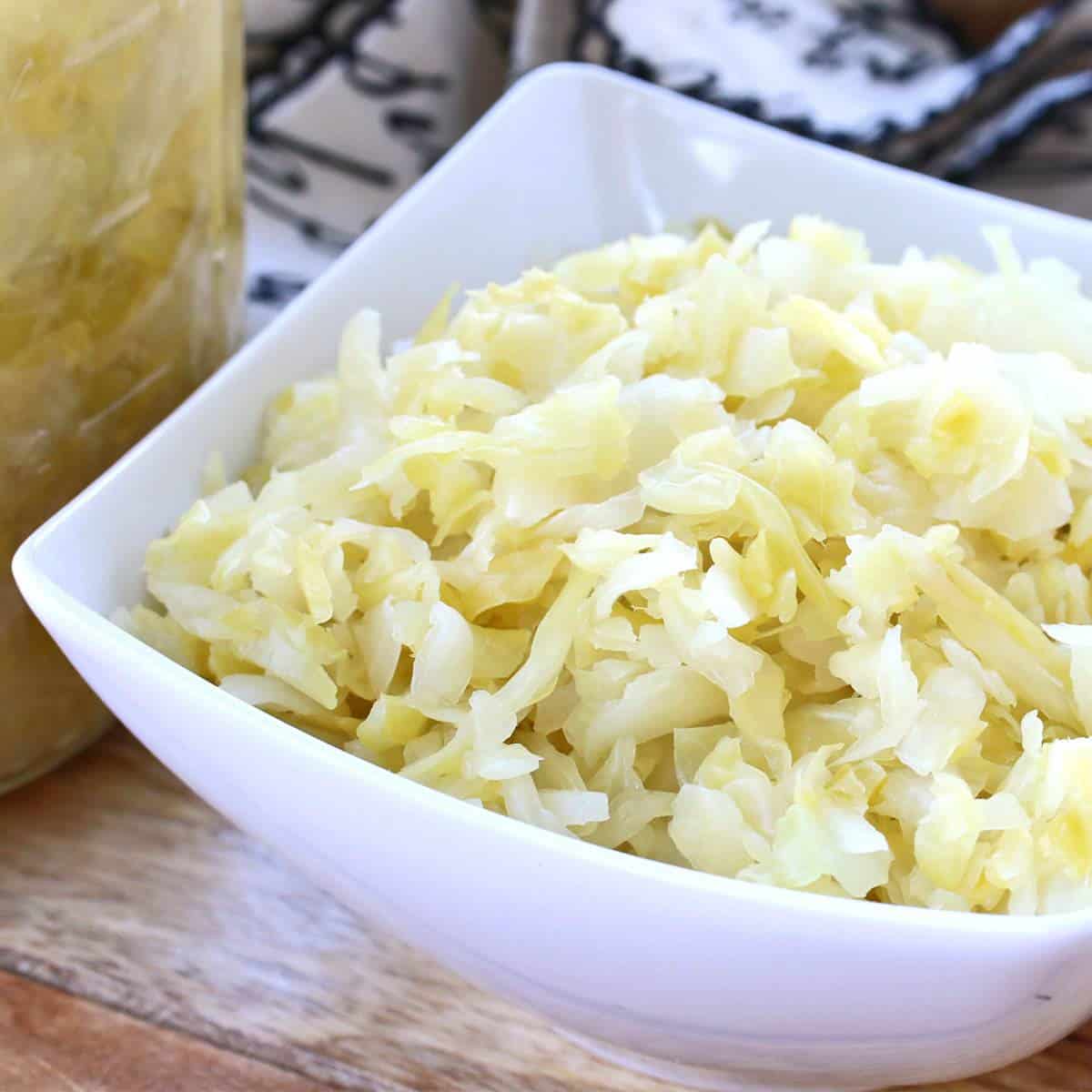
Sauerkraut is in my blood. Being from Germany and raised by a health-conscious mom, I ate this stuff on a regular basis. In Germany sauerkraut is eaten fresh or cooked in a wide variety of dishes; everything from casseroles and soups to salads or alongside meats and sausages. Raw fermented sauerkraut was always readily available in our local health food stores. My mom and I regularly went to our local Reformhaus and in the refrigerated section was a large vat of fresh sauerkraut where we could scoop out as little or as much as we wanted into the bags provided. We’d often nibble on some of it as we made our way through the outdoor shopping district and then take the rest home with us. This ancient skill has been making a comeback in recent years both overseas and in the U.S., with a growing number of people learning how to ferment their own foods.
I’ve been fermenting vegetables, grains, legumes, and dairy products for over a decade and it is a deeply satisfying venture. If you’ve been curious about how to make sauerkraut it’s time to make that leap. For anyone interested in trying their hand at fermentation, sauerkraut is the perfect place to start!
Why You Should Make Your Own Sauerkraut
The benefits of probiotics are well-established and the fact that you’re here reading this means you’re already aware of that. And you’re probably also aware that there is no better or easier way to access a wide spectrum of probiotics than making your own sauerkraut. With probiotic supplements you’re limited to a couple or few select strains. Research has shown homemade fermented sauerkraut to contain as many as 28 separate and distinct strains. No probiotic pill can replicate that. Not to mention that there is no way to verify how much of the bacteria is even still alive in probiotic supplements.
With homemade fermented sauerkraut you’re benefitting not only from a large variety of probiotic strains, you’re also getting a large dose of live, healthy, and robust ones.
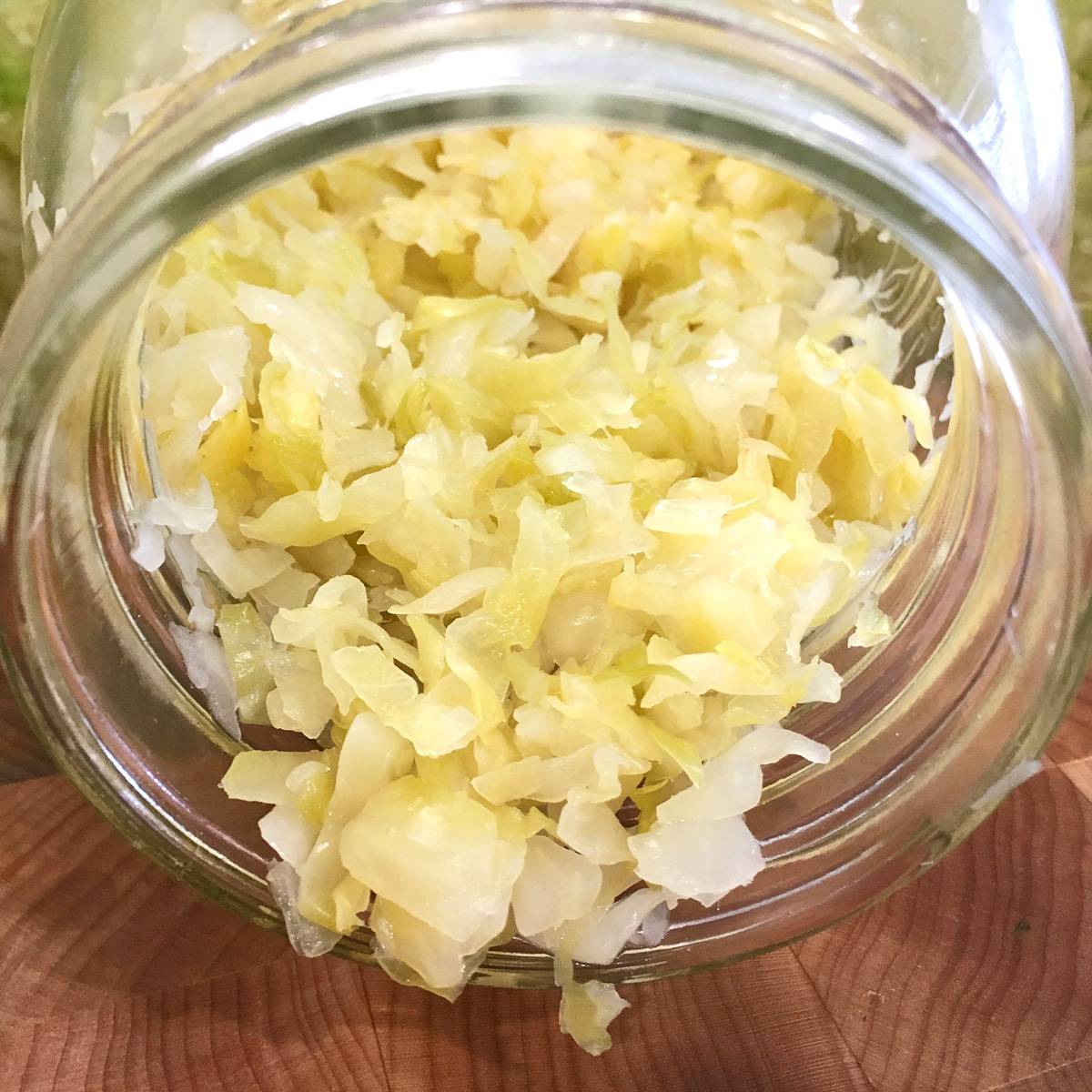
Equipment For Making Sauerkraut
You don’t need any specialized equipment to make sauerkraut.
- A large glass or ceramic jar (I regularly use half gallon Mason jars)
- Some kind of heavy, flat-bottomed tamper for crushing the cabbage
- Something flat to weigh down the cabbage that’s relatively close in size to the diameter of the jar you’re using
- Fresh cabbage
- Salt (sea salt or kosher salt)
That’s it. You don’t need any specialized tools, gadgets, or equipment. People have been successfully making sauerkraut for many centuries using the most basic supplies and chances are you already have what you need on hand and can easily improvise if you need to.
Specialized Equipment (Optional)
Alternatively you can invest in some dedicated equipment, some of which (airlock lids) will make the process more maintenance-free:
- Airlock lids – These lids prevent mold spores/yeasts from getting into the jar so that you don’t have to monitor it as closely or remove mold as it forms. They also automatically release air pressure as the veggies ferment so you don’t have to manually open the jar on a daily basis to release the pressure.
- Sauerkraut Crocks – These come in all difference sizes depending how large of batches you’re making. Some crocks come in a kit with a tamper and weight.
- Sauerkraut Tamper/Pounder – You can find these in wood or stainless steel and they allow you to pound the cabbage to release its liquid and then use it as a tamper for stuffing the cabbing in the jars.
Additional Resources
- The Art of Fermentation by Sandor Ellix Katz – The ultimate guide to fermenting anything and everything, including sauerkraut. It’s my favorite book on the subject and the one I most highly recommend.
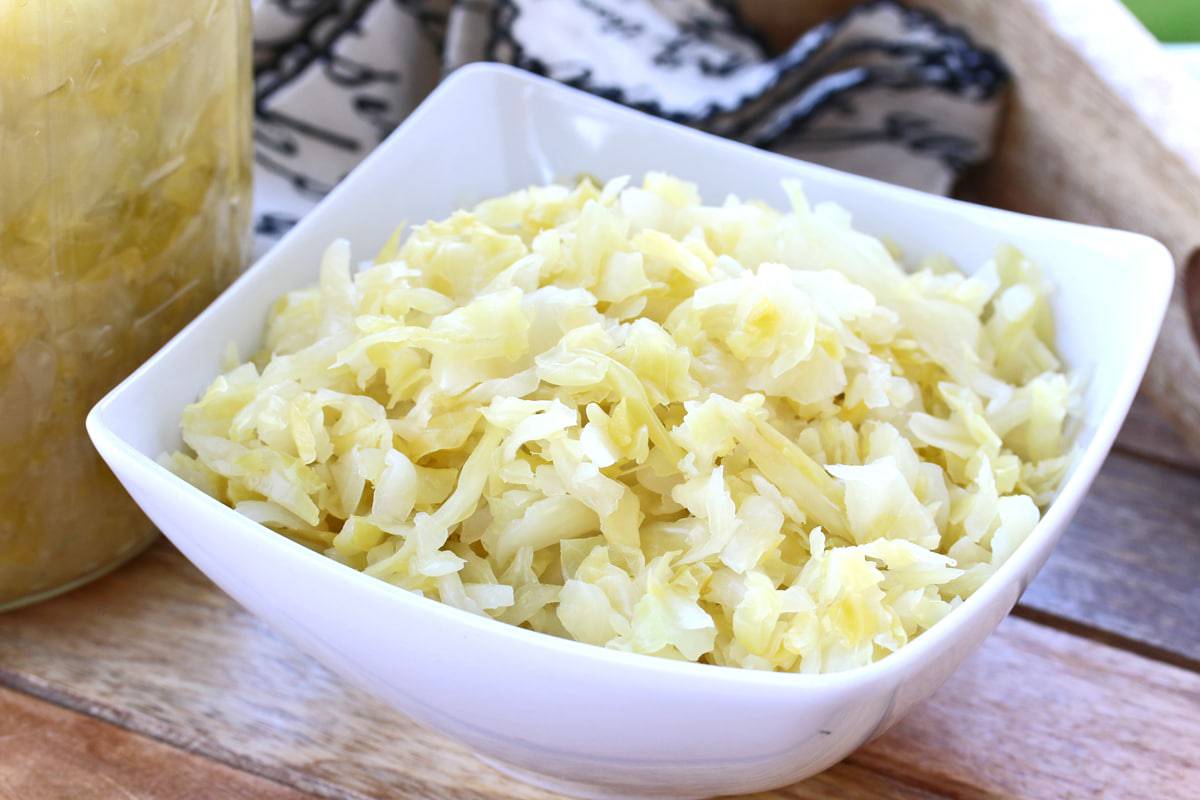
How Long Does Sauerkraut Keep?
Stored in a dark, cool place it will keep for many months. The cooler the storage area the longer it will keep. I keep mine stored in the fridge. Even in a cold environment like the fridge, sauerkraut will continue to ferment though at a much slower pace.
Can You Freeze Sauerkraut?
Yes, but just know that it will kill the probiotics. Cooking the sauerkraut will also kill the probiotics. So if your objective is to reap the benefits of the probiotics, eat it raw and unfrozen. If your objective is simply to enjoy it cooked as a delicious food (and delicious it is!), you will still reap the benefits of its vitamins and fiber.
How Long Does it Take to Ferment?
As long as you want it to until it reaches the desired texture and level of tanginess. Days. Weeks. Months. It will become tangier the longer it sits.
The length of the fermentation time will depend primarily on the temperature of the environment. The cooler the environment, the longer it will take to ferment. The warmer the environment the quicker it will ferment, the flavor will be inferior, and the sauerkraut is at greater risk of developing unwanted yeast and going bad. The ideal temperature for sauerkraut is 65-70 F. At that temperature we recommend letting it ferment for at least 2 weeks (preferably longer) but you can cut it shorter depending on your taste preference.
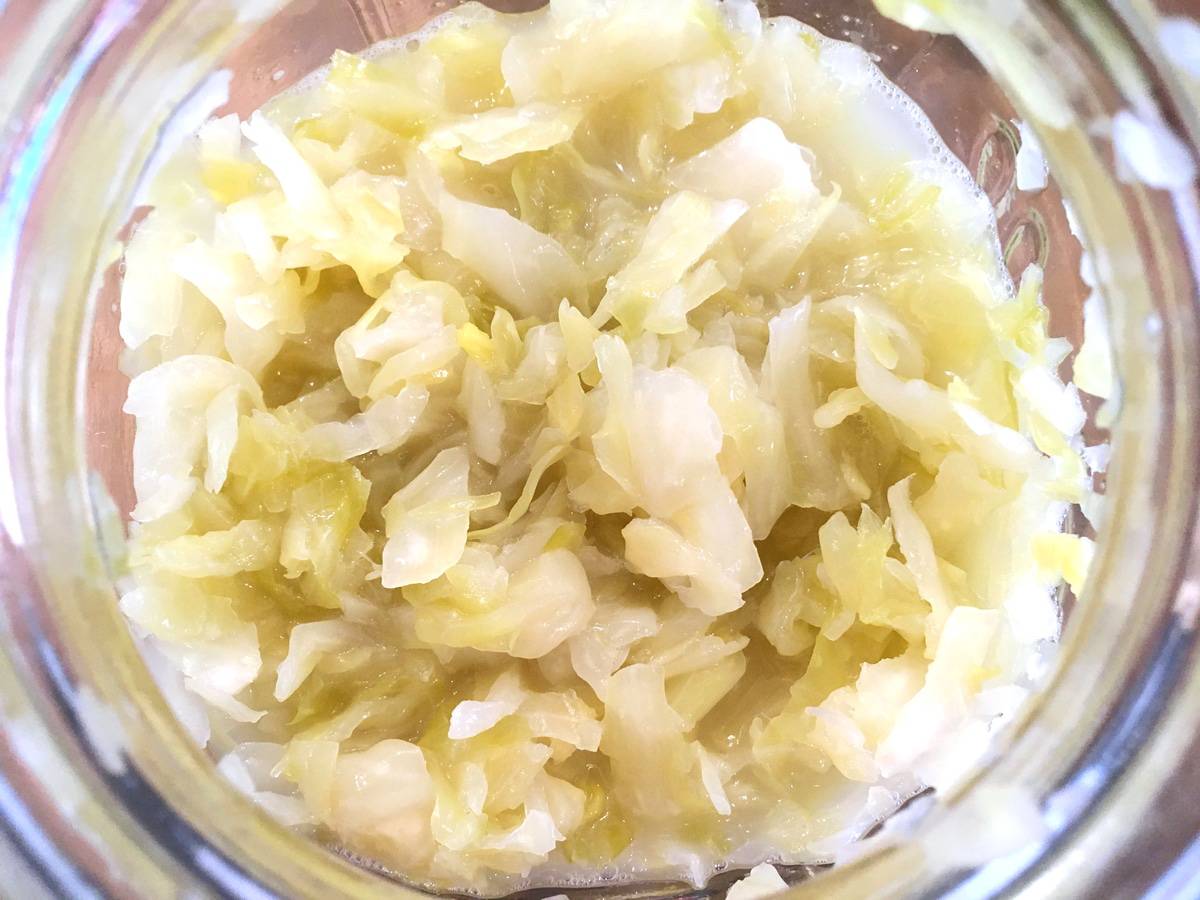
Can I Make Sauerkraut Without Salt?
While you can make sauerkraut without salt and you can find information on alternatives online, we do not recommend it. Salt is a key ingredient in fermenting foods for several reasons: 1) It creates an environment that favors the formation of lactobacillus bacteria (good bacteria) and prevents unwanted bacteria and yeast from forming, 2) It prolongs the shelf-life, 3) It helps preserve the vitamin and mineral content of the food, 4) It improves the flavor, 5) It helps keep the vegetables crisp and crunchy, and 6) It slows down the fermentation process so that the vegetables can develop a fuller, more complex flavor.
Fermented vegetables, including cabbage, do best with a salt content of 2-3%. Translated in measurements that’s 1 1/2 to 2 teaspoons of salt per pound of cabbage (9-12 grams of salt per 450 grams of cabbage).
Does Sauerkraut Go Bad?
While fermented foods are slower to go bad, they most certainly can and will in time. So how can you tell if sauerkraut is bad? See below.
There’s Mold On It: Is it Safe to Eat?
In most cases it is perfectly safe. Mold most often occurs when the cabbage isn’t submerged under the brine and comes in contact with air. When this happens it is perfectly safe to remove and discard the top layer of the sauerkraut. This is true if the mold is a greenish or grayish color. If however the mold is black, orange, or pink or if your sauerkraut has changed to an unpleasant color, slimy texture, or bad smell, then toss it.
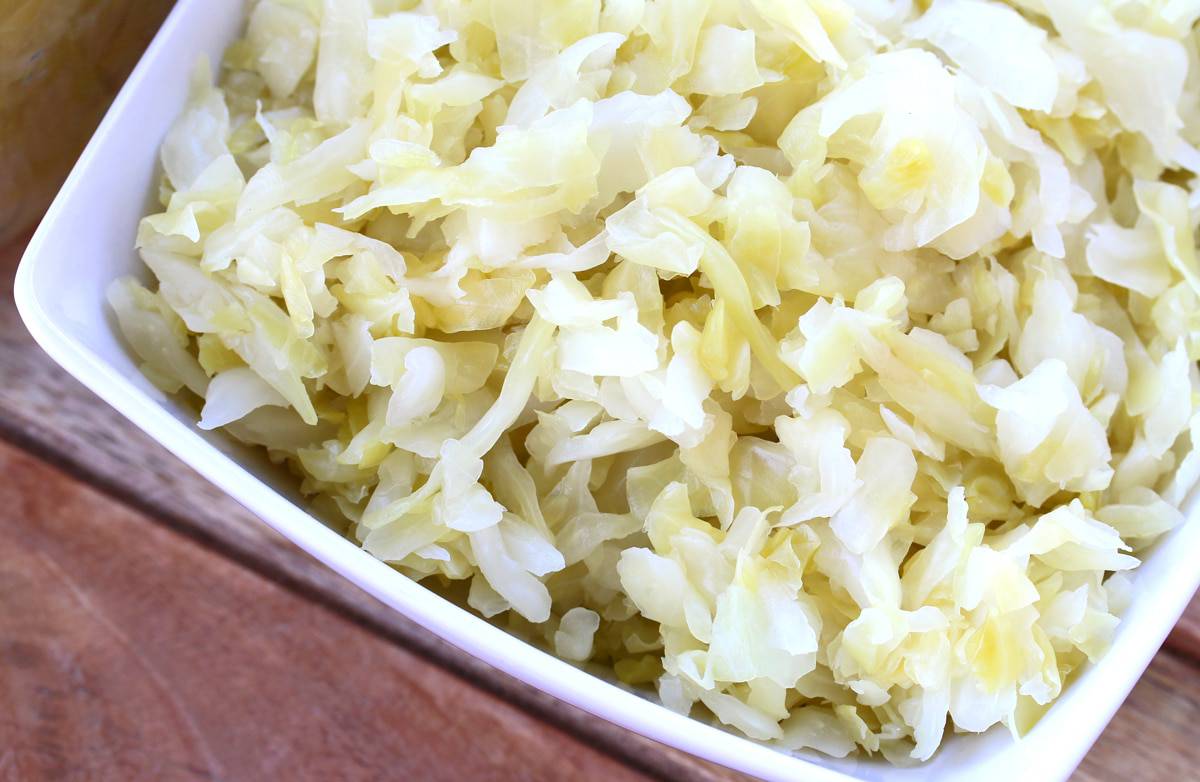
How to Make Sauerkraut
There are number of ways you can approach making sauerkraut but the overall method and principles are the same: Chop, salt, and keep the cabbage immersed under liquid until it’s fermented. There are also a number of flavor variations you can experiment with. For example, in Germany it is not uncommon to include whole, crushed juniper berries or caraway seeds.
I’m presenting a basic sauerkraut recipe but feel free to explore and experiment with flavors. Here a summary of the basic steps and below I’ll take you through those steps in detail:
- Chop the cabbage and place it in a large flat-bottomed bowl.
- Salt the cabbage.
- Pound the cabbage to release its juices.
- Transfer the cabbage to a glass or ceramic jar or crock and use a tamper to push the cabbage down into the jar to remove any air pockets until the cabbage is completely submerged under the brine.
- Place the lid on the jar, put the jar in a cool, dark place, and wait. Remove the lid every day to release air pressure, to make sure the sauerkraut is submerged under the brine.
- Taste the sauerkraut every day after the first few days until it reaches the desired texture and level of tanginess.
- Screw the lid on tight and store your finished sauerkraut in the fridge or a cool cellar.
Prepare the Cabbage:
Remove any bruised or damaged exterior leaves from the cabbage, then cut the cabbage in half and remove the core. Slice the cabbage very thinly, approximately 1/8 inch thick. For the best texture we recommend slicing it very thinly by hand, not with a food processor. You can slice it by hand, use a mandolin, or cabbage slicer.
Place the sliced cabbage in a large bowl and toss in the salt. Let it sit for about 20 minutes until the cabbage has begun to wilt and releases some of its juices. Use a tamper/pounder to crush the cabbage until it is wilted and has released a lot of liquid. This will take several minutes.
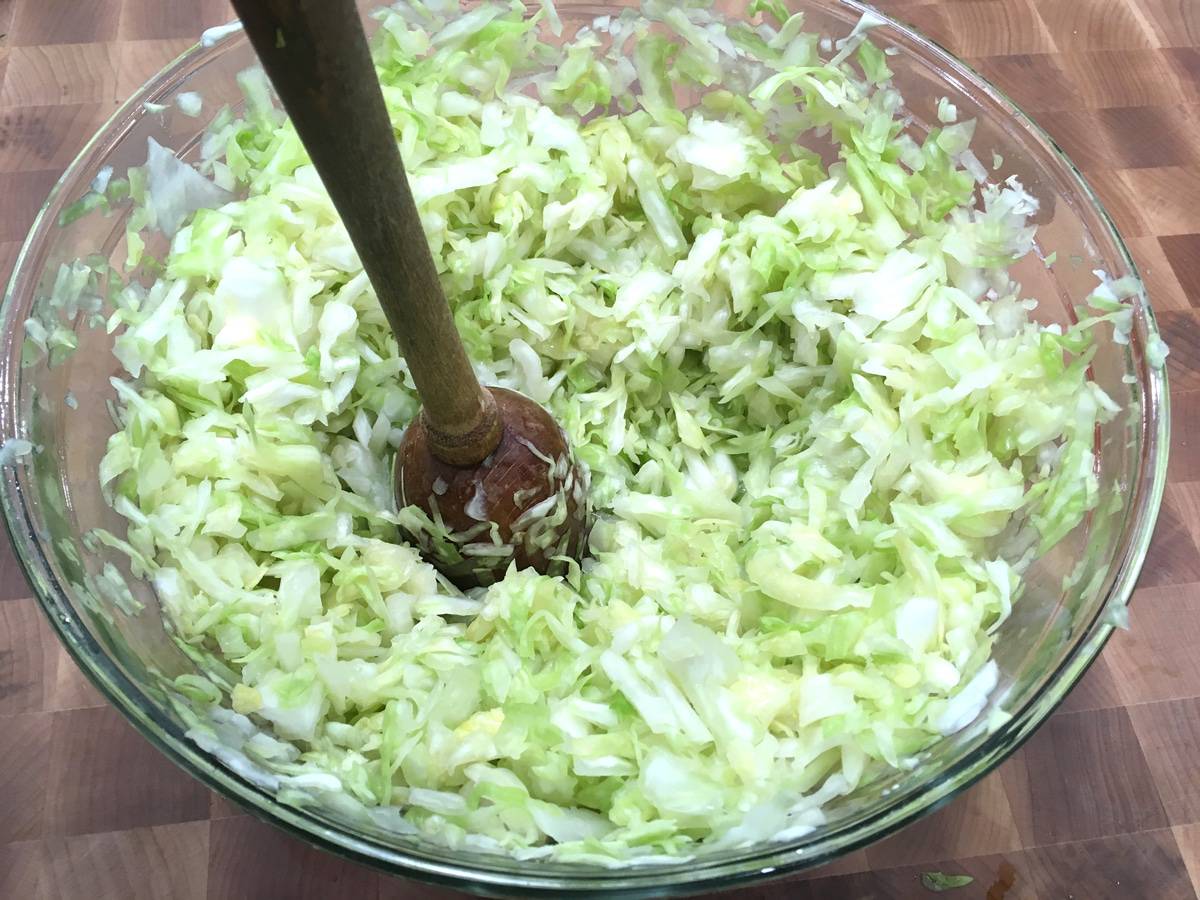
Pack the Cabbage into a Jar or Crock:
Transfer the cabbage and all the juices to a glass or ceramic jar or crock a bit at a time and mash it down with a tamper. Fill the jar to about 2/3 full (the cabbage will bubble as it ferments and could overflow if the jar is too full).
Continue to mash the cabbage with the tamper, releasing more juice, until the cabbage is completely submerged under the brine.
If you’ve mashed all you can mash and you still don’t have enough brine to cover the cabbage you’ll need to make some supplemental liquid that is consistent with the salinity of the cabbage brine: Dissolve 1 teaspoon of salt in 1 cup of water (a 2% salt water solution) and add that to the jar until the cabbage is completely submerged under the liquid.
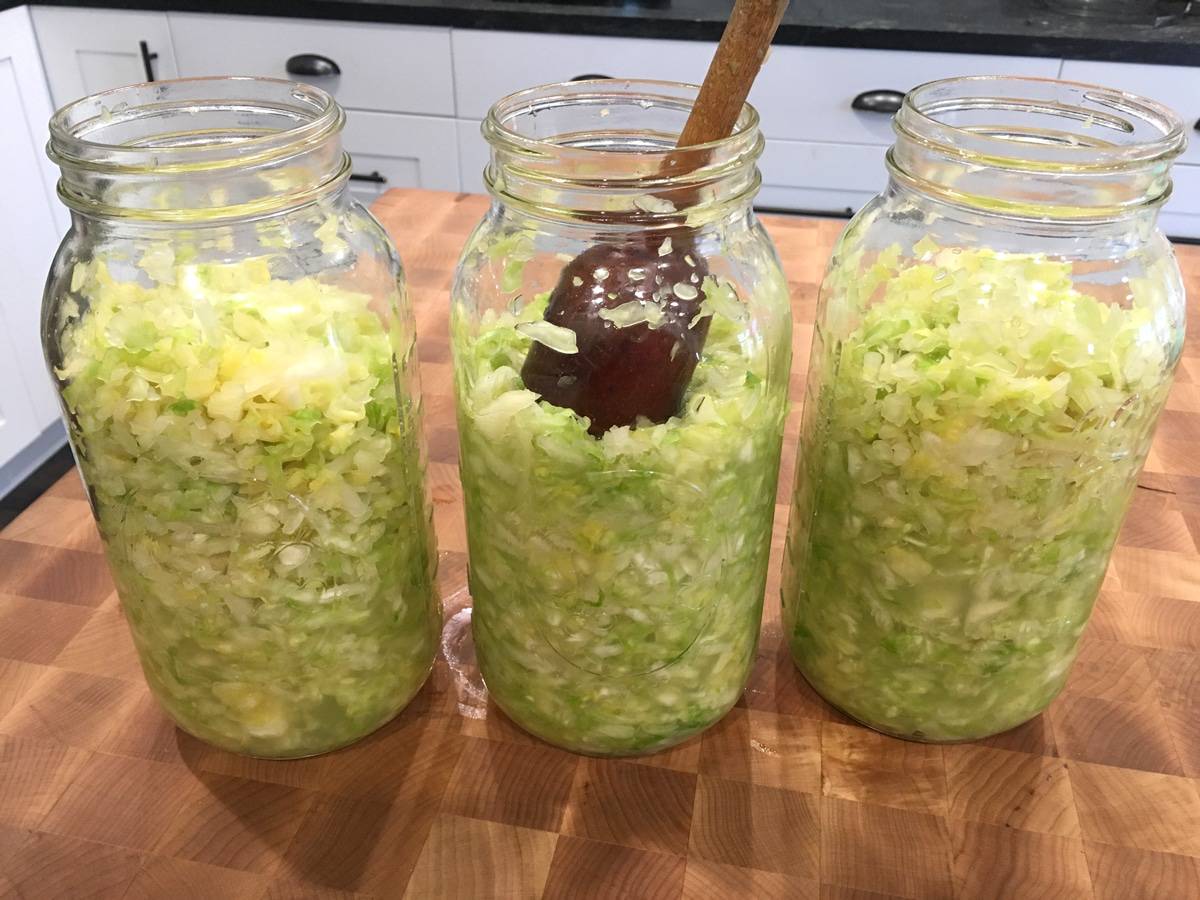
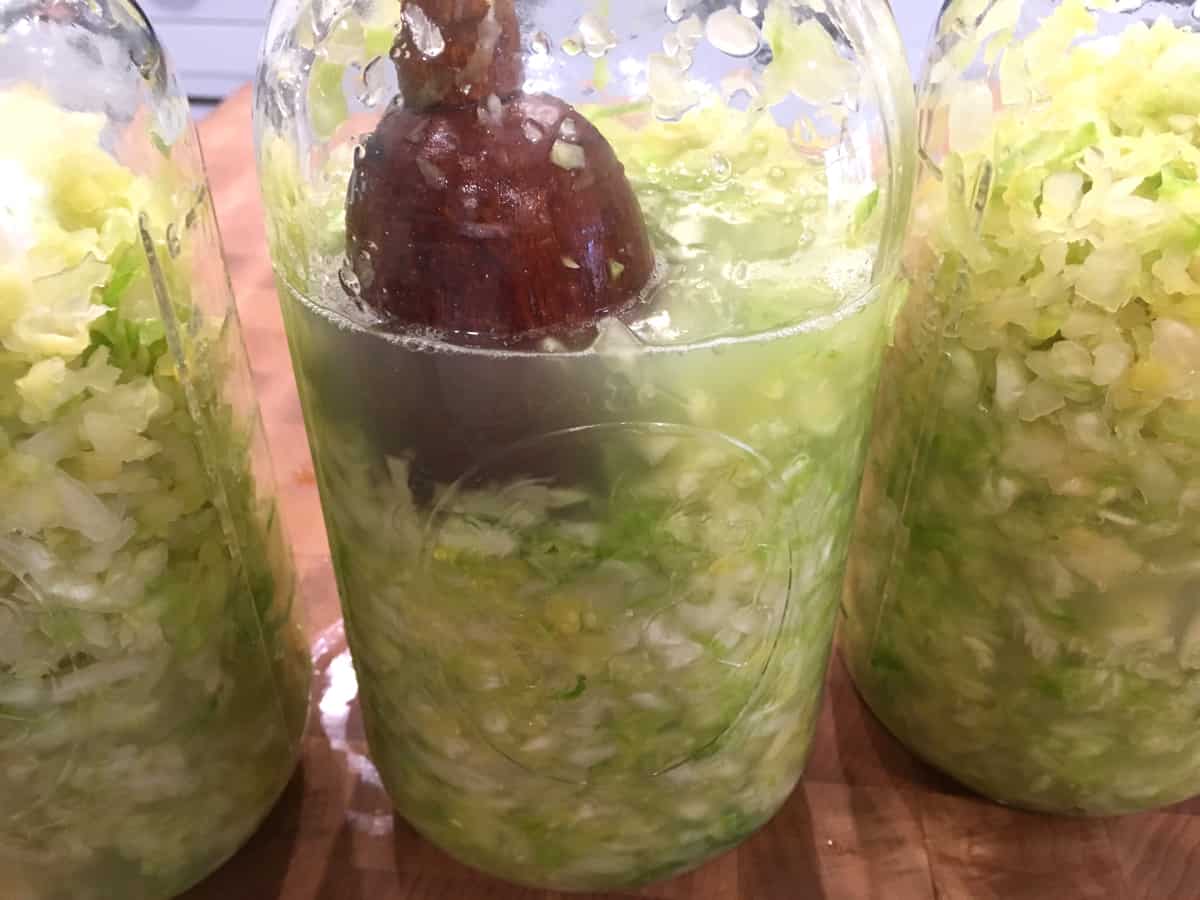
It’s also important to mash the cabbage to remove any air pockets in order to prevent mold growth.
The prep work is done.
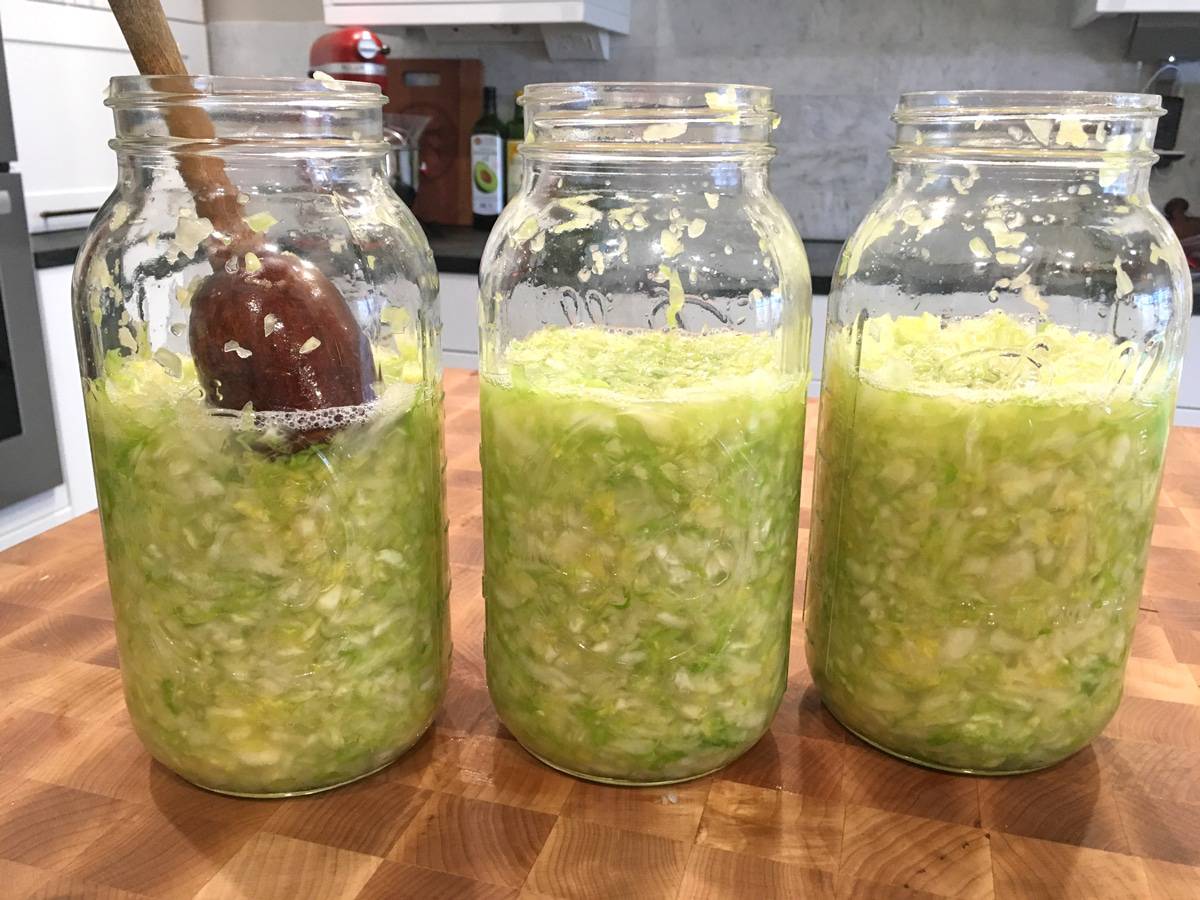
It is imperative that the cabbage remain submerged under the brine during fermentation, otherwise mold will form (See section above “My Sauerkraut Has Mold on it: Is it Safe to Eat?”). To do this choose a heavy object whose diameter is roughly the same size to the inside of the crock you’re using. The object should be glass, ceramic, or non-reactive metal.
Note: I have made sauerkraut multiples times in large mason jars (usually 1/2 gallon size) without needing to use weights. Because of the small diameter of the jar, after a day or two of fermenting the cabbage usually remains below the liquid level. If the cabbage rises above it I just mash it back down with the tamper. If you choose to use mason jars without using something to weigh down the cabbage, just be sure to keep a close eye on it each day throughout the fermentation process.

Let the Fermentation Begin!
Screw on the lids to fingertip tightness. If using airlock lids, follow the instructions provided with your lids.
Place the jars in a dark place that is between 65-70 degrees F, the ideal temperature for fermenting. (See section above “How Long Does it Take to Ferment Sauerkraut” for information on temperature variations.)
Now it’s time to WAIT.
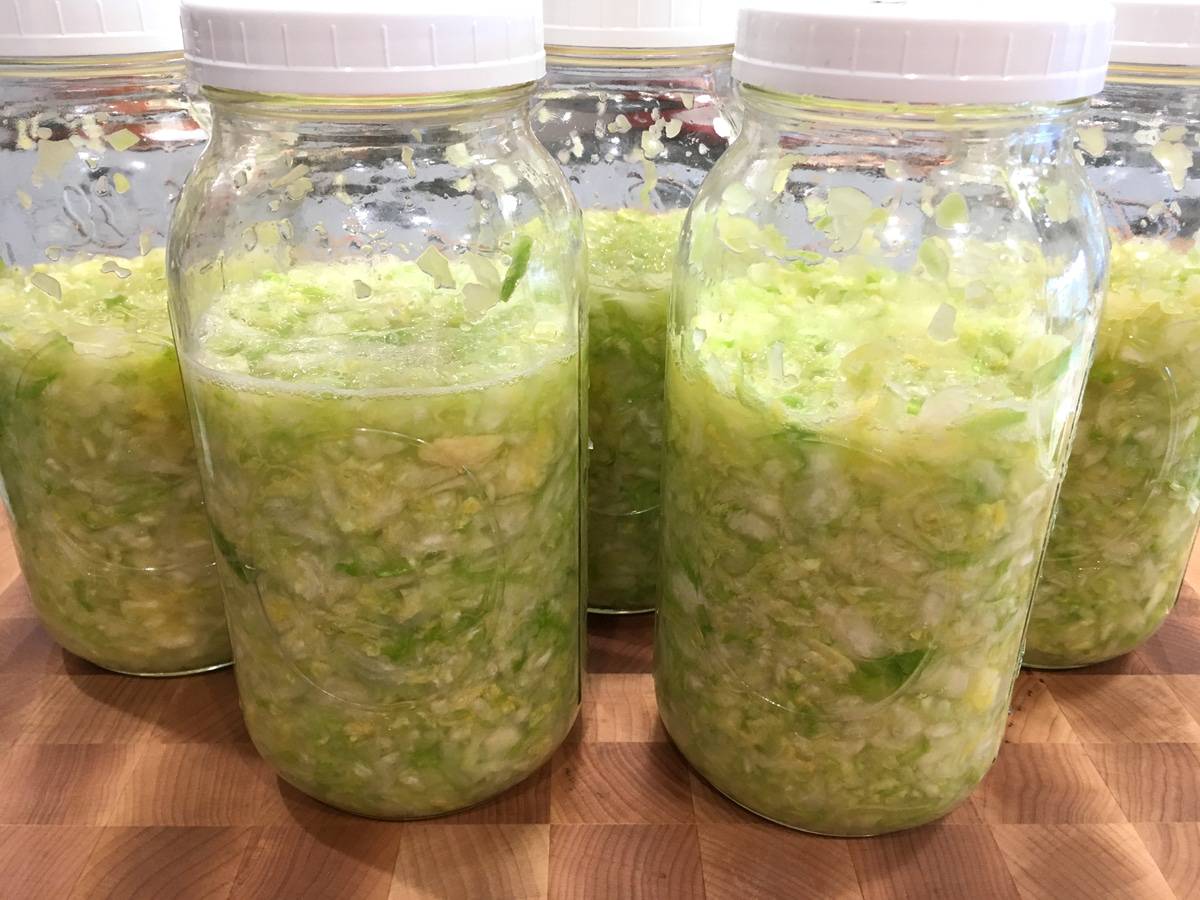
At a the ideal temperature range of 65-70 F we recommend fermenting the cabbage for at least 2 weeks (we recommend longer) but follow your own taste.
After 4 days of fermenting start tasting the cabbage daily until it reaches the desired texture and level of tanginess. Don’t be alarmed if the brine becomes fizzy, this is completely normal and a positive sign of microbial activity.
The color of the cabbage will change from green to a pale yellowish beige (in the pic below compare the green-colored cabbage in the jars, still in the early stages of fermenting, with the finished sauerkraut in the middle).
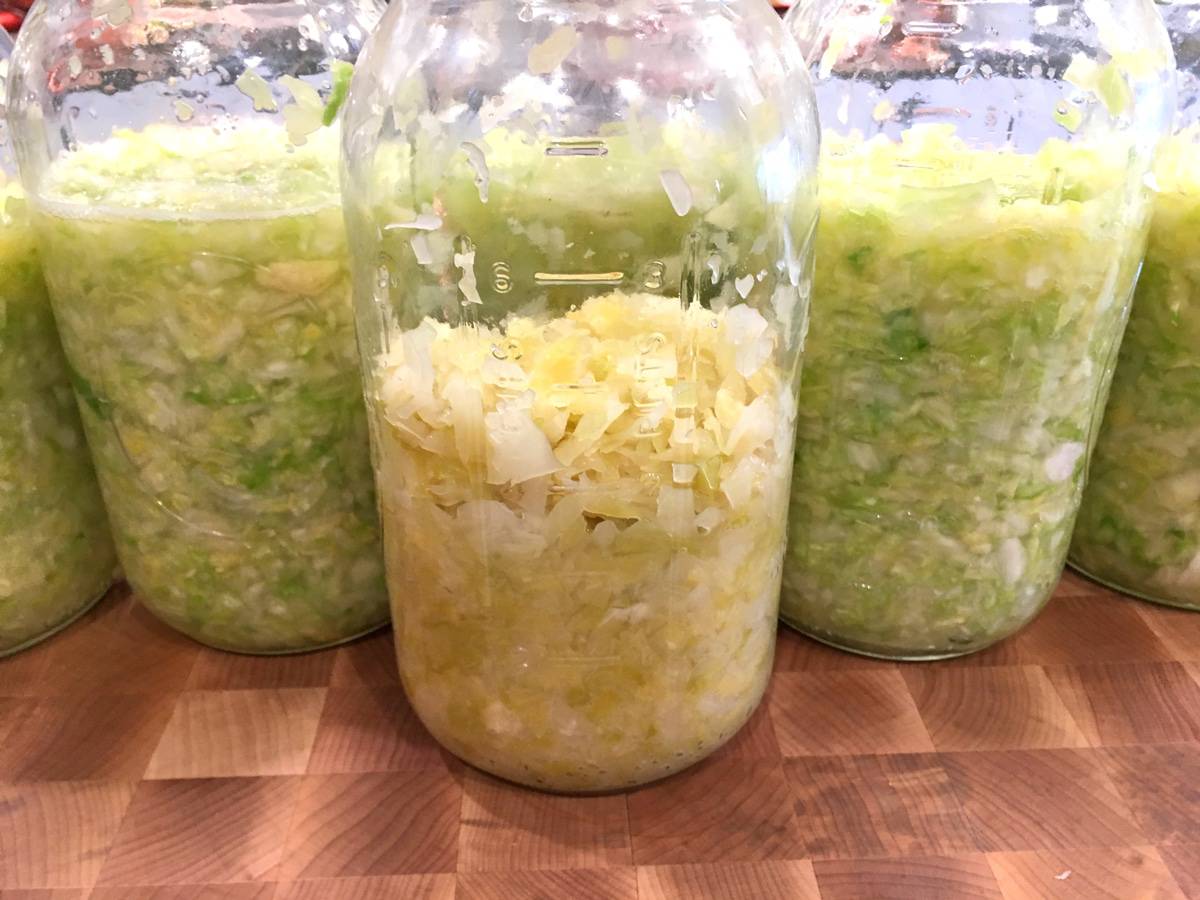
Once your sauerkraut has reached the level of tanginess that you want, it’s time to screw the lid on tight (remove the airlock lid if using and replace it with a regular lid).
Store the sauerkraut in the fridge or a cold cellar. The storage temp should be between 38-50 degrees F. Fermentation won’t stop but it will be greatly slowed down.
Stored in the fridge the sauerkraut will keep for many months. (See section above “Does Sauerkraut Go Bad?”) If your sauerkraut is too salty for your taste simply give it a rinse before eating.
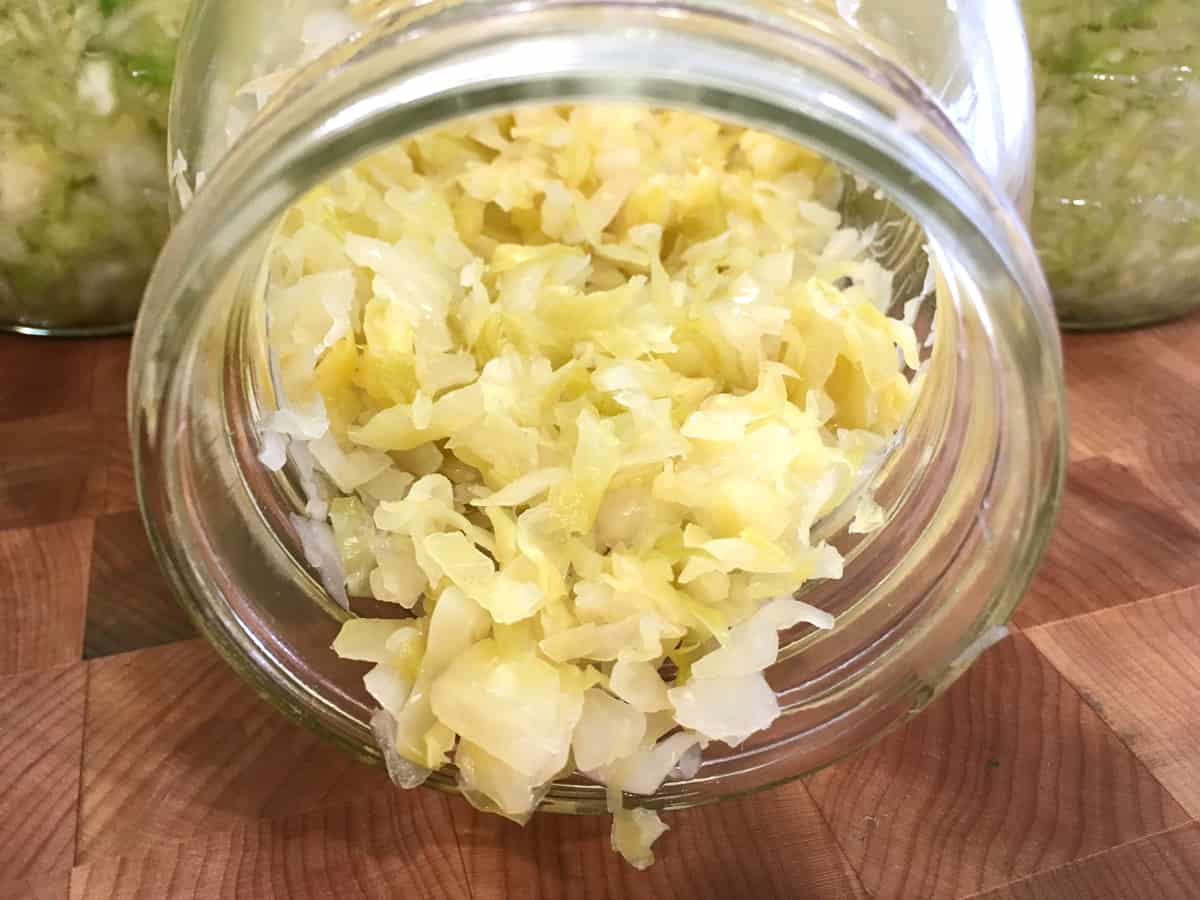
Eat your sauerkraut raw to reap the benefits of the probiotics or use it in any recipe calling for sauerkraut.
Enjoy!
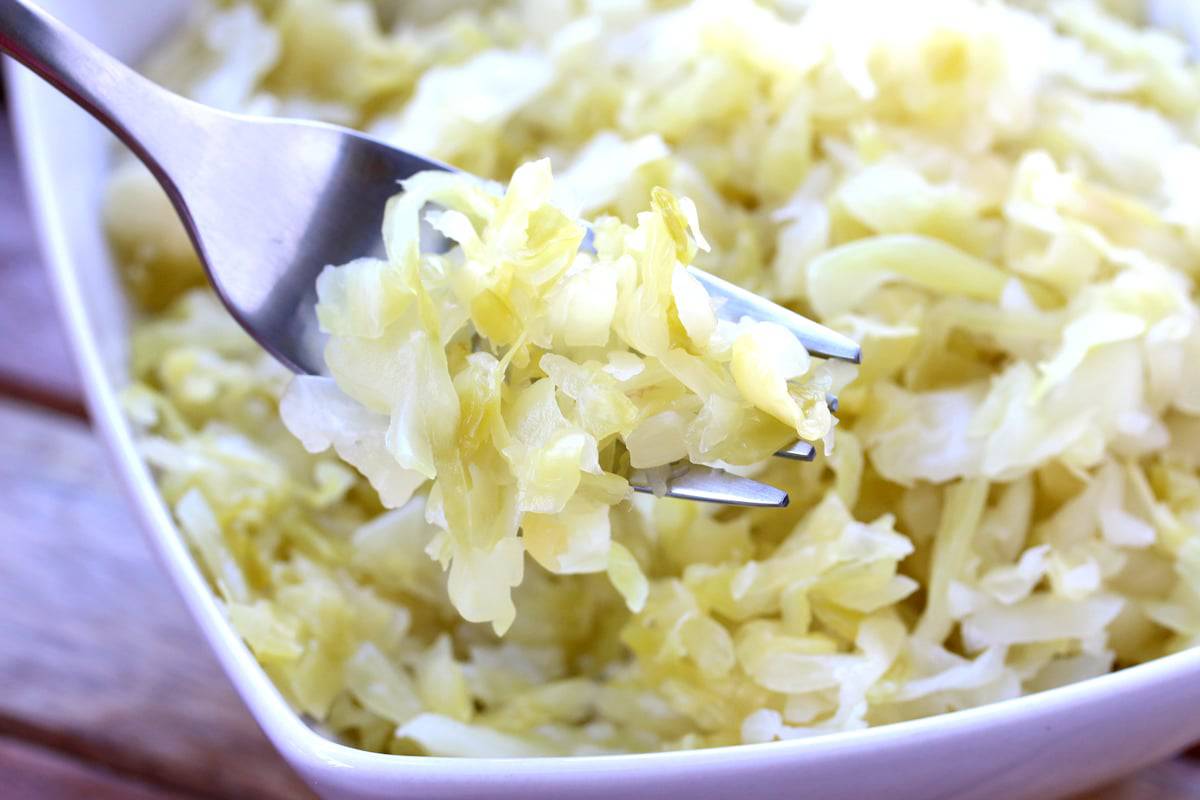
For sauerkraut recipe ideas be sure to try my:
Be sure to check out my tutorials on:
Save This Recipe
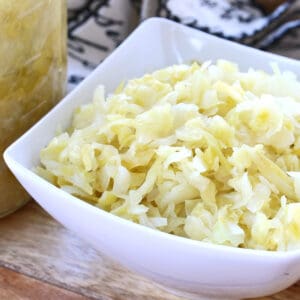
How to Make Sauerkraut
Equipment
- Jars I regularly use these ones!
Ingredients
- 1 1/2-2 teaspoons salt for every pound of cabbage (9-12 grams salt per 450 grams of cabbage) (use sea salt or kosher salt – avoid iodized salt because it can inhibit fermentation and make sure that whatever salt you use contains no anti-caking ingredients)
- very fresh green cabbage (The fresher the cabbage the more juice it will have to make a sufficient amount of brine. The finished sauerkraut will also have a much better texture.)
Instructions
- Prepare the Cabbage:Remove any bruised or damaged exterior leaves from the cabbage, then cut the cabbage in half and remove the core. Slice the cabbage very thinly, approximately 1/8 inch thick. For the best texture we recommend slicing it very thinly by hand, not with a food processor. You can slice it by hand, use a mandolin, or cabbage slicer.Place the sliced cabbage in a large bowl and toss in the salt. Let it sit for about 20 minutes until the cabbage has begun to wilt and releases some of its juices. Use a tamper/pounder to crush the cabbage until it is wilted and has released a lot of liquid. This will takes several minutes.
- Pack the Cabbage in a Crock or Jar:Transfer the cabbage and all the juices to a glass or ceramic jar or crock a bit at a time and mash it down with a tamper. Fill the jar to about 2/3 full (the cabbage will bubble as it ferments and could overflow if the jar is too full).Continue to mash the cabbage with the tamper, releasing more juice, until the cabbage is completely submerged under the brine and any air pockets have been removed (important for preventing mold growth). If you've mashed all you can mash and you still don't have enough brine to cover the cabbage you'll need to make some supplemental liquid that is consistent with the salinity of the cabbage brine: Dissolve 1 teaspoon salt in 1 cup water (a 2% solution of salt water) and add that to the jar until the cabbage is completely submerged under the liquid.It is imperative that the cabbage remain submerged under the brine during fermentation, otherwise mold will form (See blog section "My Sauerkraut Has Mold on it: Is it Safe to Eat?"). To do this choose a heavy object whose diameter is roughly the same size to the inside of the crock you're using. The object should be glass, ceramic, or non-reactive metal.Note: I have made sauerkraut multiples times in large mason jars (usually 1/2 gallon size but you can use smaller jars) without needing to use a weight. Because of the small diameter of the jar, after a day or two of fermenting the cabbage usually remains below the liquid level. If the cabbage rises above it I just mash it back down with the tamper. If you choose to use mason jars without using something to weigh down the cabbage, just be sure to keep a close eye on it each day throughout the fermentation process.Screw on the lids to fingertip tightness (this is important to prevent exploding jars!). If using airlock lids, follow the instructions provided.
- Ferment Your Sauerkraut:Place the jars in a dark place that is between 65-70 degrees F, the ideal temperature for fermenting. (See blog section "How Long Does it Take to Ferment Sauerkraut" for information on temperature variations.)At a the ideal temperature range of 65-70 F we recommend fermenting the cabbage for at least 2 weeks (we recommend longer) but follow your own taste.After 4 days of fermenting start tasting the cabbage daily until it reaches the desired texture and level of tanginess. Don't be alarmed if the brine becomes fizzy, this is completely normal and a positive sign of microbial activity.Note: If you're not using an airlock lid be sure to open the lid of your jar/crock every day to release the pressure and prevent your jar from exploding. The color of the cabbage will change from green to a pale yellowish beige.
- Store Your Sauerkraut: Once your sauerkraut has reached the level of tanginess that you want, it's time to screw the lid on tight (remove the airlock lid if using and replace it with a regular lid).Store the sauerkraut in the fridge or a cold cellar (storage temperature should be between 38-50 degrees F). Fermentation won't stop but it will be greatly slowed down. Stored in the fridge the sauerkraut will keep for many months. (See blog section "Does Sauerkraut Go Bad?") If your sauerkraut is too salty for your taste simply give it a rinse before eating. Eat your sauerkraut raw to reap the benefits of the probiotics or use it in any recipe calling for sauerkraut.
Originally published on The Daring Gourmet January 2, 2021



















Fabulous recipe! I’ve made this twice. Flavor is great. Texture is great. I love the crunch of the cabbage. Sometimes store-bought kraut is mushy. I love this! Thanks for the recipe!
Fantastic, thank you so much, Katie!
Should cabbage be washed in the process?
Hi Crystal, typically the outer leaves are removed as they’re commonly a little bruised, and there is no need to wash the remaining cabbage.
Thanks for sharing this! What sort of spices or vegetable flavorings could one use to perk up, or add layers to the flavor of the kraut?
I would definitely put caraway seeds in, Paul!
In the past I have placed a little crushed garlic cloves, peppercorns, and caraway. Hope this helps. Whatever sounds good to you will taste good in the kraut. Enjoy, hope this helps some.
Hi, instead of using cabbage, can I use mustard green (without the leaves) to make this sauerkraut?
Hi Max, yes you can use this same process for fermenting a lot of different vegetables. I have a batch of collard greens going right now. Something to note though is that unlike kraut made with cabbage, kraut made with most greens has a VERY strong and unpleasant flavor. Many describe it as the smell and taste of a decaying animal ;) So I suggest a very short ferment (use your nose and taste to determine) and even then it’s something not many can stomach.
Instead of combining the cut cabbage and salt together before putting it in the jar … could one put only the cut cabbage in the jar and then add the measured amount of salt dissolved in a small amount of water and pour that over the cut cabbage
Hi Richard, I suppose you could do that but you’ll still need to thoroughly mash the cabbage, that step is key, and it’s just easier to do that in a large bowl rather than after it’s inside of the jar.
I have 5 gallon food grade buckets will this work for my crock?? you’ve mentioned ceramic, or glass….
Hi Caitlin, I just personally like to avoid plastics in general but yes, as long as they’re actually food-grade you can use them.
thank you for your recipe! i’m going to attempt to make this this weekend. wondering if i could also use red cabbage, in addition to the green?
Hi Amanda, yes you can!
Really a fantastic and detailed tutorial. My sauerkraut turned out beautifully. Now off to make another batch, this time doubling it!
This is the second time I’m following your recipe, the first one I made last year turned out fine, perhaps I could have left it fermenting longer because it was less tangy than I ideally like, but still yummy and as I stored it in the fridge for months it matured nicely.
I set another batch yesterday, this time with some red cabbage plus crushed juniper berries and chilli, really looking forward to the final result. But this time of year the temperature is about 17-20 C, which is within your recommended range, and it hasn’t started producing bubbles yet, literally no sign of activity – I’m pretty sure the fermentation started overnight last year but I can’t remember exactly which month that was and what temperature. I wonder what is the normal timeframe for any visible start of fermentation?
Hi Vicky, trying to set specific timeframes when it comes to wild” yeast and bacteria just isn’t possible. They really do have minds of their own! :) Two batches in very similar conditions can behave quite differently in terms of timeframes and flavor outcomes. That’s just the nature of all these independently acting, live bacterias. If your red cabbage kraut hasn’t started to bubble yet there’s nothing wrong, it just needs some more time. Salt also acts as an inhibitor in slowing down the fermentation process, making it take longer, so it may be that you added a little more salt this time? Either way, just give it more time.
I was just wondering once I have the Sauerkraut complete will it be fine to put into mason jars and seal them in pressure cooker or water bath??
Hi Robin, that’s a great question. It definitely wouldn’t be safe to do it in a water bath and I’ve never tried pressure canning it. Perhaps one of our readers knows more about this and can chime in.
on oct. 6, robin asked about canning this. for some reason i cannot reply directly to the comment, so i will do it here. yes, do not use a water bath. this is low acid (no acid?) and must be pressure canned. (anything can be pressure canned, but a lot of stuff becomes totally disgusting.) a 1qt. jar needs 20 minutes from room temp. to assure a good seal, you can do it like this: 1) leave enough head room in the jar to prevent boil over. 2) microwave the jar (no metal) to warm the contents. 3) boil the water in the canner, add lid and band (loose but on,) add the jar. (without microwaving, boil the water and heat the jar together.) process 20 mins. 4) let pressure release naturally. 5) check lids for seal. reprocess if necessary. reprocessed product will be inferior.
can I do green tomatoes t
this was a really easy recipe to follow. good sense and with equipment most every household would already have. The only variation I made was using red cabbage instead of green as I had a small head on hand. Love the measurements in grams too.
Thank you so much for the feedback, Paul, I’m so glad it was a success!
It worked and tasted awesome!! Better than store bought for sure. Used this recipe for my second try as the first time I tried it with a different recipe, it ended up tasting funny lol. Really appreciate that you broke down how much salt to use per 450gms..
Used fresh homegrown and organic cabbages, really happy with end produce. Thank you very much!
That’s wonderful, Yan, I’m so glad! As a fellow organic gardener I know those homegrown cabbages as precious so I’m very happy this was a success. Thank you so much for the feedback!
Hello – Have you ever canned it, to make it more shelf stable? Or do how long will it last in a colder basement?
I’m anxious to give this a try. How many heads of cabbage would you estimate would be needed for a 5 gallon crock?
Hi Beth, a 5 gallon crock typically holds around 25 pounds of cabbage (5 pounds cabbage per 1 gallon crock).